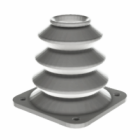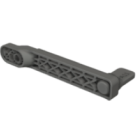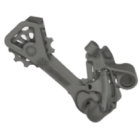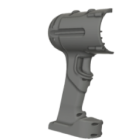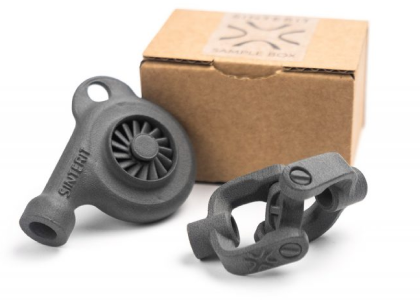MJF 3D printing
Multi Jet Fusion (MJF) is an industrial powder-bed 3D printing technology developed by HP. Known for its speed, part strength, and excellent surface finish, it’s become a serious alternative to both SLS and FDM for functional prototypes and production-grade parts.
In this section, we’ll explore what is MJF 3D printing, how it works, which materials it uses, and how it compares to other technologies like FDM and SLS.
What is MJF 3D printing technology?
At its core, MJF 3D printing is a powder-based additive manufacturing process. Unlike SLS, which uses a laser to fuse powder particles, MJF relies on inkjet arrays to selectively deposit a fusing agent and a detailing agent onto a heated powder bed. Infrared energy is then applied, and the fusing agent absorbs that energy to melt the powder precisely where needed.
The result: layer-by-layer solidification of the part with excellent resolution and mechanical properties — without the need for traditional support structures.
So when people ask “what is MJF printing?” or “what is MJF 3D printing?”, the answer is: a jetting-based, heat-activated powder-bed fusion process that delivers production-grade polymer parts with speed and precision.
MJF 3D printing process explained
The MJF 3D printing process consists of the following stages:
- cooling & depowdering — the build chamber cools slowly before parts are unpacked and cleaned,
- powder layering — a thin layer of powder (typically pa12) is spread across the build area,
- agent jetting — inkjet nozzles apply two agents,
- fusing agent on the part geometry,
- detailing agent around the edges for sharper definition,
- infrared heating — a scanning lamp passes over the layer, causing the fusing agent to absorb energy and melt the powder selectively,
- layer repetition — the process repeats layer by layer until the part is complete,
Materials used in MJF 3D printing
Today, the most common MJF 3D printing material is PA12 (nylon 12) — known for its strength, durability, and chemical resistance. HP and other providers have since expanded the portfolio to include:
- PA11 — tougher and more flexible than PA12,
- PA12 GB (glass bead-filled) — stiffer and dimensionally stable,
- TPU — for flexible parts like seals and wearable components,
- color-capable materials — for full-color prototyping in some Jet Fusion models.
Like in SLS, unused powder can be recovered and reused, often up to 80%, which contributes to lower operating costs and sustainability.
Surface quality and dimensional accuracy
MJF excels in surface quality and dimensional accuracy, often producing smoother parts than SLS with sharper edges. The detailing agent helps reduce edge bleed and improves fine feature definition, making MJF suitable for parts with small holes, thin walls, or snap-fit connections.
Post-processing is relatively simple: no support removal is needed, and parts can be sandblasted, dyed, or coated depending on the application.
MJF vs FDM: which 3D printing is better?
While FDM is widely used for prototyping, MJF outperforms it in almost every metric when it comes to final part production.
| Feature | MJF | FDM |
|---|---|---|
| Surface finish | Smooth, matte | Layer lines visible |
| Strength | Isotropic in XY/Z | Weaker in Z-axis |
| Speed (per batch) | High – builds entire layer | Slower – sequential paths |
| Materials | PA12, PA11, TPU | PLA, ABS, PETG, etc. |
| Post-processing | No supports needed | Requires support removal |
| Best for | Functional parts, low-volume production | Prototypes, simple parts |
MJF vs FDM comes down to one key idea: FDM is great for concept models; MJF is built for final-use parts.
MJF vs SLS — key differences and use cases
MJF and SLS are often compared because they both use powdered thermoplastics and don’t require supports. However, their mechanisms — and results — differ in important ways.
| Feature | MJF | SLS |
|---|---|---|
| Heat source | Infrared + jetting agents | Laser sintering |
| Build speed | Faster (entire layer fused at once) | Slower (point-by-point laser scan) |
| Edge sharpness | Excellent (due to detailing agent) | Good, but often slightly fused edges |
| Powder reuse | High | Moderate to high |
| Maintenance | Requires printhead calibration | Requires laser calibration |
| Cost (machine) | Higher entry cost | More open, wider hardware range |
If your workflow demands speed, high definition, and consistent part performance, MJF printing may be the right fit — but SLS remains the more flexible and often more cost-efficient option, especially for in-house production with open materials. Learn more in our dedicated guide on Selective Laser Sintering.
When should you choose MJF 3D printing?
MJF is ideal when you need:
- short-run functional parts,
- high-precision prototypes,
- smooth surface finishes without post-processing,
- fast throughput in an industrial setting,
- batch production with consistent tolerances.
It’s widely used in automotive, consumer electronics, orthotics, and manufacturing aids.
MJF 3D printing: summary and key takeaways
To recap, MJF 3D print technology offers:
- powder-based production with no supports,
- fast, precise builds with excellent resolution,
- strong nylon parts suitable for end-use applications,
- a powerful alternative to both FDM and SLS.
While MJF is not as open or affordable as SLS systems, it delivers a tightly controlled process with minimal variability — making it especially appealing for applications where consistency is key.
Explore also
- Overview of 3D printing tech
- What is SLS printing?
- What is FDM 3D printing?
- What is SLA 3D printing?
- DLP 3D printing
- What is DMLS and SLM 3D printing?
- Binder Jetting
- Material Jetting
- PolyJet printing
- New 3D printing technology
- 3D print vs injection molding
Related categories




